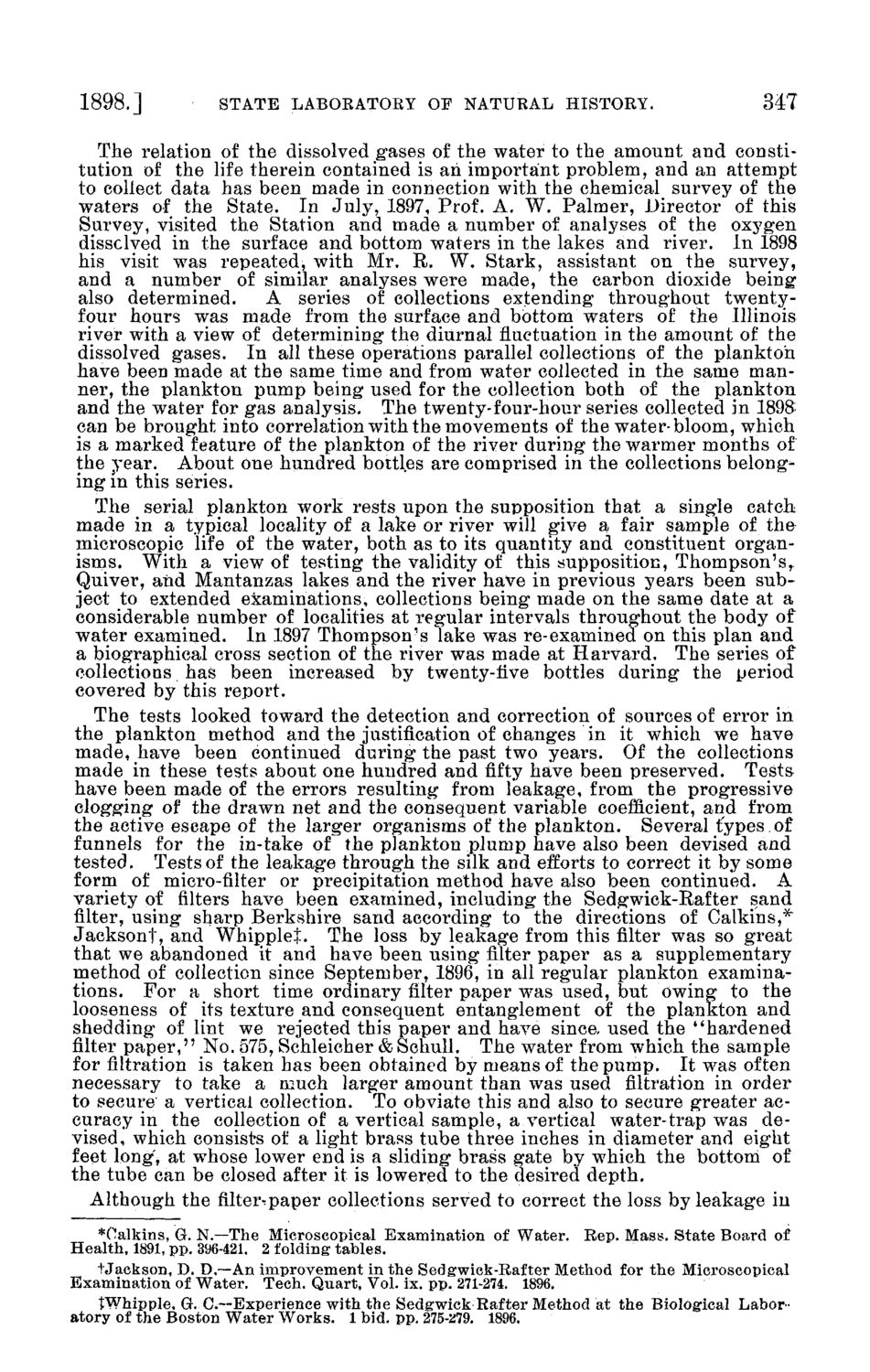| |
| |
Caption: Board of Trustees Minutes - 1898
This is a reduced-resolution page image for fast online browsing.

EXTRACTED TEXT FROM PAGE:
1898.] STATE LABOEATOKY OF NATURAL HISTORY. 347 The relation of the dissolved gases of the water to the amount and constitution of the life therein contained is ah important problem, and an attempt to collect data has been made in connection with the chemical survey of the waters of the State. In July, 1897, Prof. A. W. Palmer, Director of this Survey, visited the Station and made a number of analyses of the oxygen dissolved in the surface and bottom waters in the lakes and river. In 1898 his visit was repeated, with Mr. R. W. Stark, assistant on the survey, and a number of similar analyses were made, the carbon dioxide being also determined. A series of collections extending throughout twentyfour hours was made from the surface and bottom waters of the Illinois river with a view of determining the diurnal fluctuation in the amount of the dissolved gases. In all these operations parallel collections of the plankton have been made at the same time and from water collected in the same manner, the plankton pump being used for the collection both of the plankton and the water for gas analysis. The twenty-four-hour series collected in 1898 can be brought into correlation with the movements of the water-bloom, which is a marked feature of the plankton of the river during the warmer months of the vear. About one hundred bottles are comprised in the collections belonging in this series. The serial plankton work rests upon the supposition that a single catch made in a typical locality of a lake or river will give a fair sample of tho microscopic life of the water, both as to its quantity and constituent organisms. With a view of testing the validity of this supposition, Thompson's, Quiver, and Mantanzas lakes and the river have in previous years been subject to extended examinations, collections being made on the same date at a considerable number of localities at regular intervals throughout the body of water examined. In 1897 Thompson's lake was re-examined on this plan and a biographical cross section of the river was made at Harvard. The series of collections has been increased by twenty-live bottles during the period covered by this report. The tests looked toward the detection and correction of sources of error in the plankton method and the justification of changes in it which we have made, have been continued during the past two years. Of the collections made in these tests about one hundred and fifty have been preserved. Tests have been made of the errors resulting from leakage, from the progressive clogging of the drawn net and the consequent variable coefficient, and from the active escape of the larger organisms of the plankton. Several types of funnels for the in-take of the plankton plump have also been devised and tested. Tests of the leakage through the silk and efforts to correct it by some form of micro-filter or precipitation method have also been continued. A variety of filters have been examined, including the Sedgwick-Hafter sand filter, using sharp Berkshire sand according to the directions of Calkins,* Jacksonf, and WhinpleJ. The loss by leakage from this filter was so great that we abandoned it and have been using filter paper as a supplementary method of collection since September, 1896, in all regular plankton examinations. For a short time ordinary filter paper was used, but owing to the looseness of its texture and consequent entanglement of the plankton and shedding of lint we rejected this paper and have since, used the *'hardened filter paper," No. 575, Schleicher & Schull. The water from which the sample for filtration is taken has been obtained by means of the pump. It was often necessary to take a much larger amount than was used filtration in order to secure a vertical collection. To obviate this and also to secure greater accuracy in the collection of a vertical sample, a vertical water-trap was devised, which consists of a light brass tube three inches in diameter and eight feet long, at whose lower end is a sliding brass gate by which the bottom of the tube can be closed after it is lowered to the desired depth. Although the filter^paper collections served to correct the loss by leakage in *Oalkins, G. N.—The Microscopical Examination of Water. Rep. Mass. State Board of Health, 1891, pp. 396-421. 2 folding tables. tJack son, D. D.—An improvement in the Sedgwick-Rafter Method for the Microscopical Examination of Water. Tech. Quart, Vol. ix. pp. 271-274. 1896. tWhipple, G. C—Experience with the Sedgwick Rafter Method at the Biological Laboratory of the Boston Water Works. 1 bid. pp. 275-279. 1896.
| |